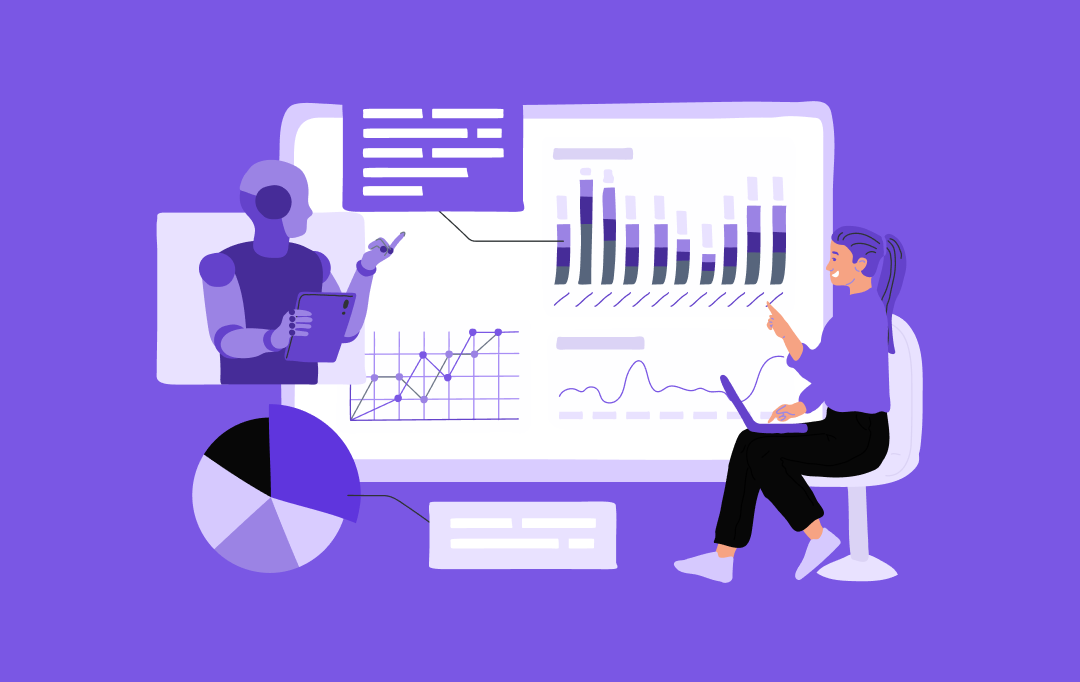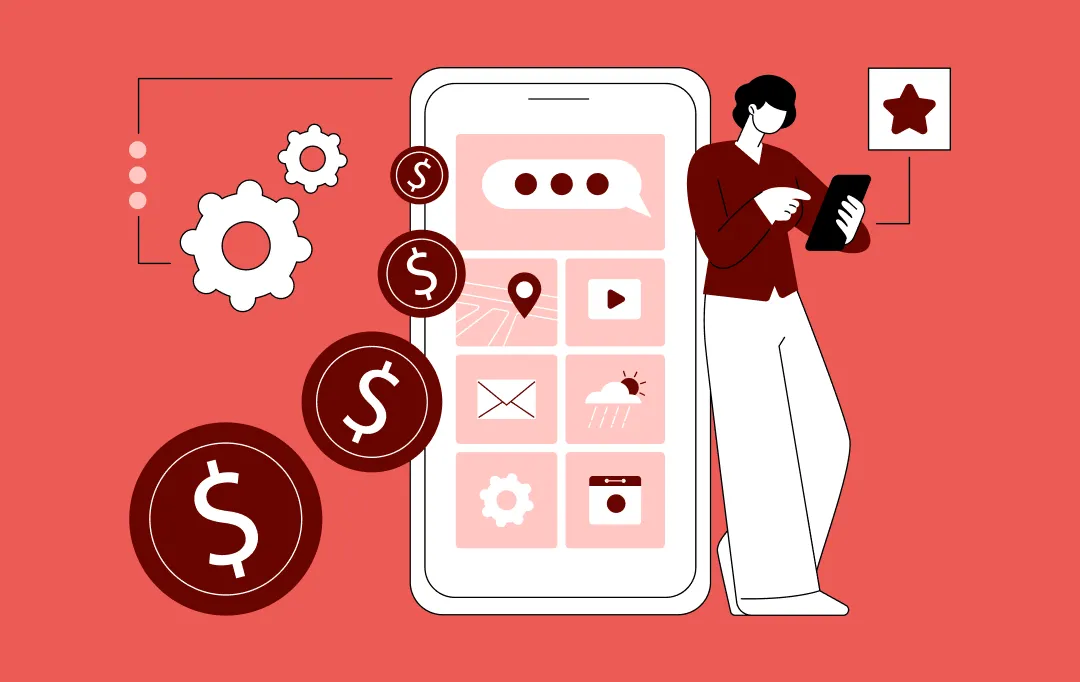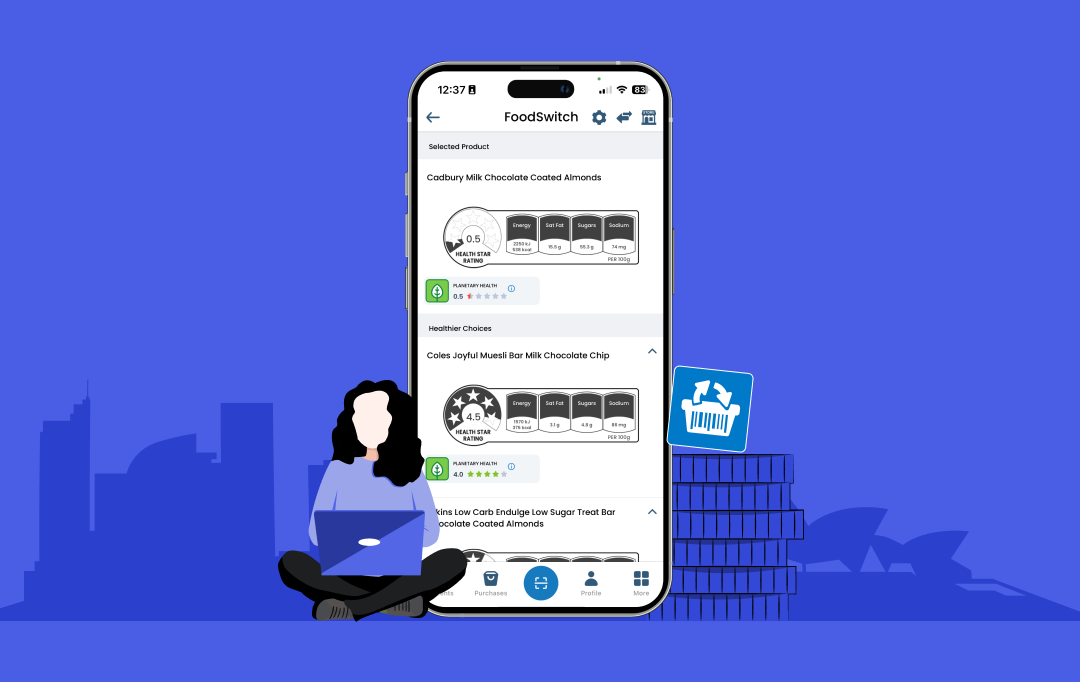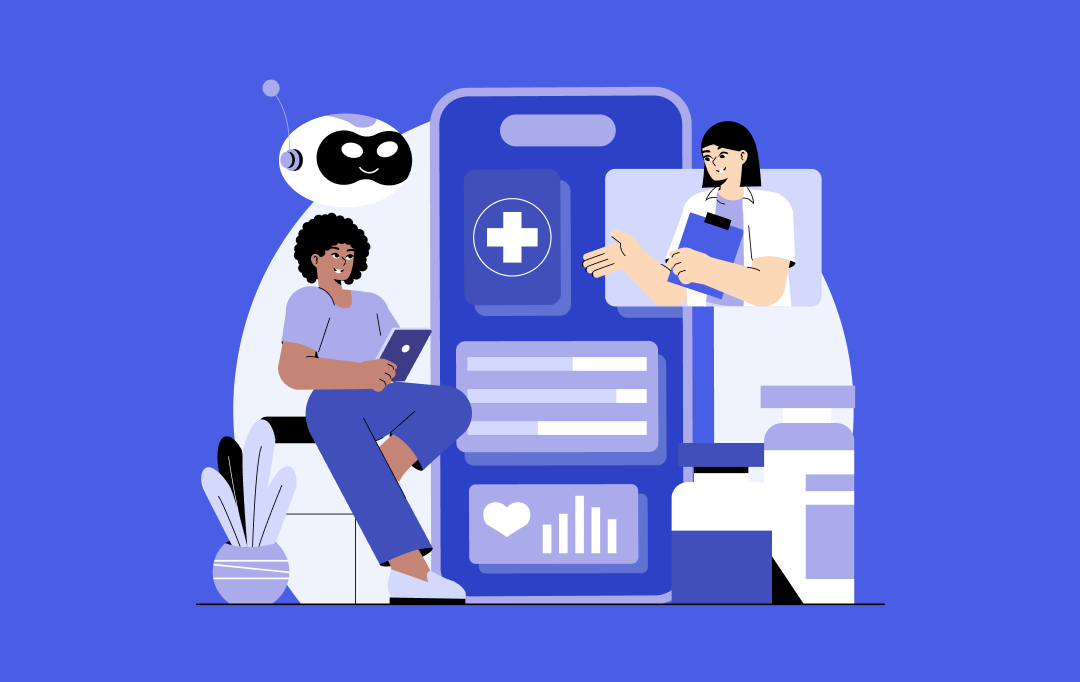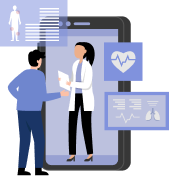- Inside the Digital Shift: How Physical Therapy Apps Are Redefining Modern Healthcare
- Types of Physical Therapy Apps Businesses Can Develop
- Benefits of Physical Therapy App Development for Modern Healthcare Businesses
- Key Benefits Driving Physical Therapy App Development for Healthcare Leaders
- 1. Better Patient Engagement
- 2. Therapy That Fits Real Life
- 3. Smarter, Data-Based Decisions
- 4. Easier Clinic Operations
- 5. Built-In Privacy and Compliance
- Real-World Use Cases Driving the Future of Physical Therapy Apps
- Post-Surgery Rehabilitation
- Sports and Athletic Recovery
- Chronic Pain Management
- Senior and Home-Based Care
- Corporate and Workplace Wellness
- Pediatric and Developmental Therapy
- Step-by-Step Process of Developing a HIPAA-Compliant Physical Therapy App
- Step 1: Research, Map, and Plan for Compliance
- Step 2: Shape the Product and Its Structure
- Step 3: Design for Humans, Not Just for Screens
- Step 4: Build and Connect the Core
- Step 5: Integrate AI and Smart Features
- Step 6: Test Like a Regulator Would
- Step 7: Deploy and Document Everything
- Step 8: Keep It Updated and Audited
- Core Features of a Physical Therapy App
- Advanced Features for an AI-Powered Physiotherapy App
- Challenges of Physical Therapy App Development
- Future Trends of Physical Therapy Apps: Redefining the
- AI-Driven Personalization
- Virtual Reality and Immersive Rehab
- Wearables and Predictive Health
- Hybrid and Remote Care
- Smarter Data Security and Compliance
- Integration with Robotics and Digital Twins
- A Broader Wellness Ecosystem
- Experience That Builds Confidence
- Security from the Ground Up
- Custom-Built, Never Cookie-Cutter
- Designed for Scale and Stability
- Long-Term Partnership and Support
- FAQs
Key Takeaways
- Physical therapy app development blends care, technology, and compliance.
- The market is growing fast, projected to reach $2.5B by 2030.
- Costs range between $50K–$350K+, based on features and integrations.
- AI, VR, and wearable tech are redefining how patients recover.
- HIPAA compliance must be built from the first stage, not added later.
- Post-launch maintenance and security updates keep apps compliant and trusted.
- Building a custom MVP helps test adoption before scaling enterprise-wide.
Let’s be honest – traditional physiotherapy is hitting a wall. Clinics are packed, follow-ups are inconsistent, and patients often drop out before completing their recovery plans. Meanwhile, digital-first competitors are quietly changing the game with apps that deliver guided therapy sessions, progress tracking, and real-time communication, all without making their patients step inside a clinic.
If you’re leading a healthcare business today, this is the moment to rethink patient engagement. The real question isn’t if you should go digital but how to do it securely, effectively, and in compliance with regulations like HIPAA. That’s where physical therapy app development becomes a true growth lever.
Creating a HIPAA-compliant physical therapy app isn’t just about digitizing exercises. It’s about blending patient data security with intelligent features like remote monitoring, virtual consultations, and personalized rehab plans. Whether you’re exploring custom physical therapy application development or planning to build your first virtual therapy platform, understanding the process, compliance, and cost matters.
Typically, the development cost for a robust physiotherapy mobile app ranges between $50,000 and $350,000+, depending on scope, integrations, and security depth. But the ROI goes far beyond numbers, it’s about better retention, improved recovery rates, and a stronger brand position in the evolving healthtech market.
In this blog, we’ll walk you through what it really takes to create a physiotherapy application, from must-have features and core components to tech stack, development steps, and future trends shaping the industry. By the end, you’ll have a clear, actionable view of how to build a compliant, scalable, and patient-centric digital experience that stands out in the healthcare landscape.
The growth window is open, but timing matters. Want to see what it’ll take to turn your idea into a compliant, scalable product?
Inside the Digital Shift: How Physical Therapy Apps Are Redefining Modern Healthcare
In 2023, the global physical therapy software market hit a valuation of $1.25 billion. By 2030, it’s expected to more than double to $2.52 billion, growing at a CAGR of 11%. That kind of curve doesn’t happen by chance, it’s the result of a larger movement happening across healthcare and wellness.
Consumers aren’t waiting for clinic appointments anymore. They want on-demand care, personalized rehab plans, and measurable progress right on their phones. What used to be a once-a-week session with a therapist has evolved into virtual physical therapy app development, where guided exercises, progress tracking, and secure video consultations happen anytime, anywhere.
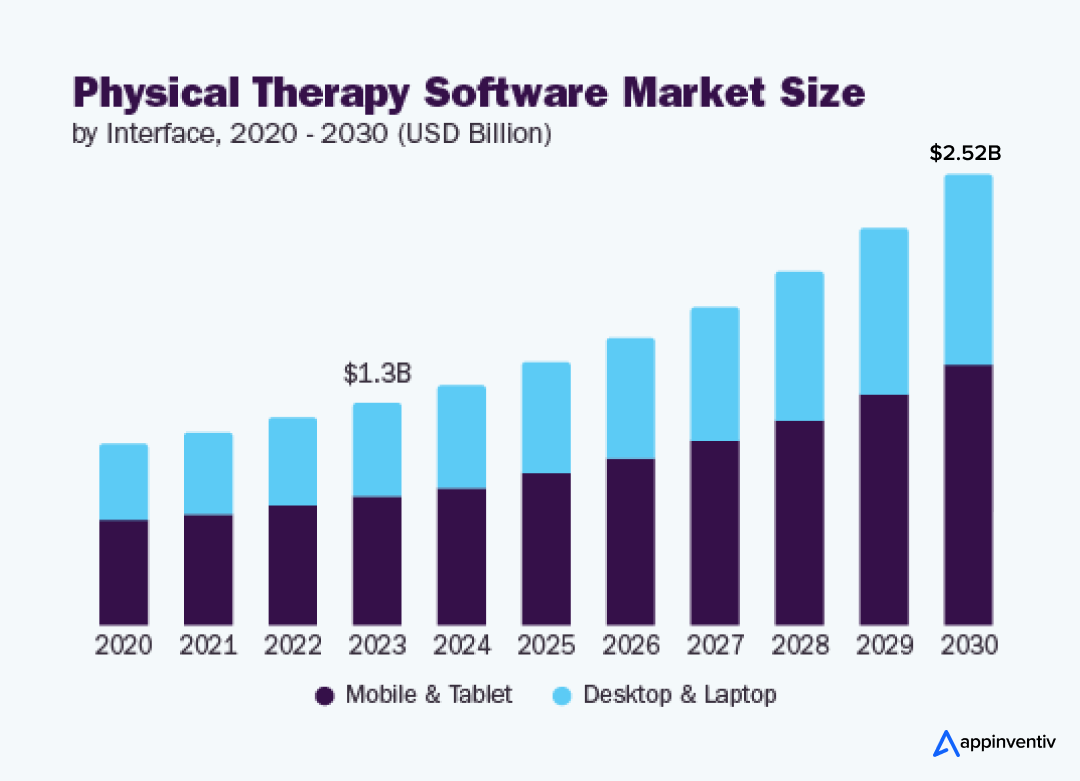
Reports from McKinsey’s Future of Wellness survey back this up. The $2 trillion wellness industry is no longer limited to fitness and nutrition but expanding into connected health. Millennials and Gen Z see wellness as a daily, tech-enabled practice. And one of the fastest-emerging subcategories? Smart physical therapy apps for patients. These apps are becoming core to longevity and mobility, supporting everything from post-injury recovery to chronic pain management.
The takeaway for business leaders is simple: now isn’t the time to observe but it’s the time to build. Healthcare providers, medtech startups, and digital health firms already investing in HIPAA-compliant physical therapy app development are gaining a competitive edge. They’re combining data-driven care with convenience, building trust through privacy compliance, and setting new benchmarks for engagement and retention.
If you’re a healthcare innovator, this is your signal. The market is shifting fast, and custom physical therapy application development today is all about getting ahead of a wave that’s redefining the future of care.
Types of Physical Therapy Apps Businesses Can Develop
When business leaders plan to develop physical therapy apps, it helps to map the landscape first. The category is broader than it looks. Some apps focus on remote care, others on clinic operations, and a few bring AI into motion analysis. Here is a simple view you can use in roadmap discussions.
| Type of App | What it does | Example |
|---|---|---|
| Virtual physical therapy apps | Secure video sessions, guided home programs, progress tracking, and remote check-ins | Kaia Health, SWORD Health |
| Exercise and rehab apps | Step-by-step routines, form cues, timers, and adherence reminders for safe recovery at home | PhysiApp, myRehab |
| Clinic practice management apps | Scheduling, intake, billing, documentation, outcomes reporting for multi-location clinics | SimplePractice, Clinicient Insight |
| AI-powered physiotherapy apps | Computer vision or sensor data to assess movement, personalize plans, and predict recovery timelines | Hinge Health, Mira Rehab |
| Patient engagement and education apps | Content, self-assessments, notifications, and insights that keep patients motivated between visits | PT Pal, PhysioU |
| Wearable-integrated apps | Sync with IMUs and smart devices to capture real-time kinematics and activity data | Move.ai, DorsaVi |
Benefits of Physical Therapy App Development for Modern Healthcare Businesses
Let’s face it – physical therapy has always relied on consistency. But keeping patients engaged once they walk out of the clinic is tough. That’s why physical therapy apps have become such a turning point for clinics and startups alike.
These apps keep the therapist connected to the patient, bring structure to recovery, and make compliance a built-in part of the process. A well-made HIPAA-compliant physical therapy app doesn’t just look good on paper but it actually makes therapy easier, safer, and more predictable. Let’s look into the detailed benefits of AI-driven physiotherapy apps:
Key Benefits Driving Physical Therapy App Development for Healthcare Leaders
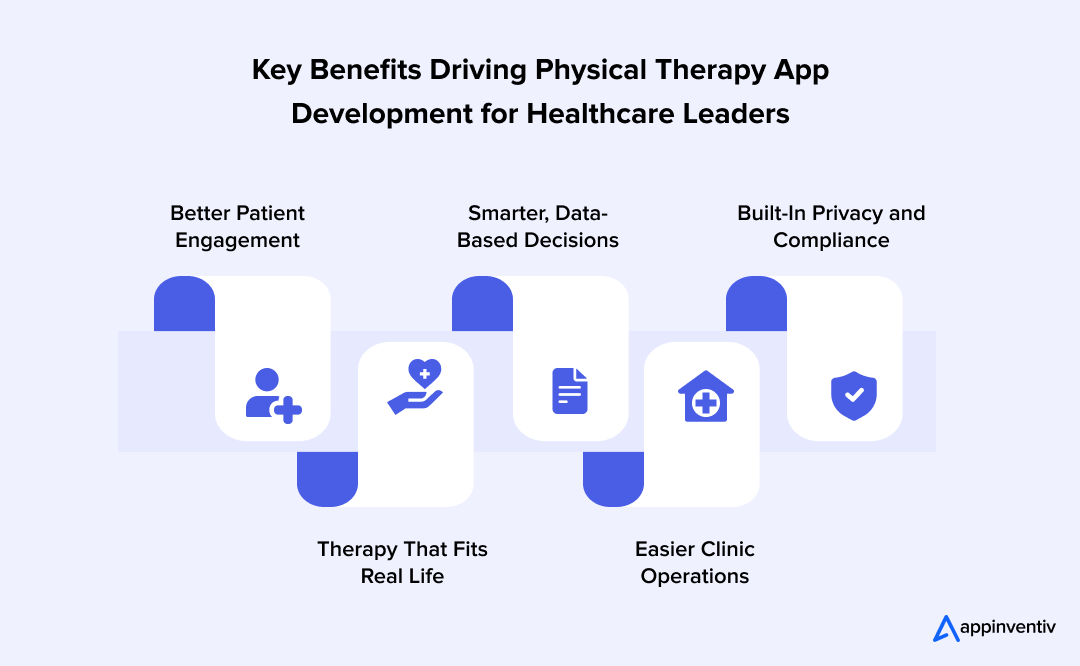
1. Better Patient Engagement
Most people start strong and drop off after a few sessions. Smart apps fix that. They send small nudges, show visible progress, and adjust routines when users skip or struggle. It’s the same therapy plan, just supported by steady, human-feeling reminders that keep people moving.
2. Therapy That Fits Real Life
With virtual physical therapy apps, location stops being a problem. Patients can check in over a secure video call, do guided stretches, or share quick progress clips. Therapists save travel time, patients stay consistent, and everyone wins.
3. Smarter, Data-Based Decisions
When an app tracks motion, duration, and effort, therapists no longer have to guess what’s happening between visits. AI-powered physiotherapy apps turn that stream of activity data into trends and alerts. It helps clinicians adjust treatment instead of waiting for the next in-person check.
4. Easier Clinic Operations
Behind the scenes, physical therapy practice management apps handle the boring stuff like scheduling, billing, records, and notes. It cuts the paperwork load, reduces mistakes, and frees therapists to focus on the actual sessions that drive results.
5. Built-In Privacy and Compliance
Healthcare data is sensitive. HIPAA-compliant smart physical therapy apps for patients keeps every file encrypted, limits who can see what, and logs each access. Patients get peace of mind, and providers stay clear of regulatory trouble.
Real-World Use Cases Driving the Future of Physical Therapy Apps
The rise of physical therapy app development isn’t just about digitizing rehab but also about solving real problems across industries and age groups. From hospitals and sports academies to corporate wellness programs, these apps are quietly transforming how people recover, move, and stay healthy. Below are some of the most impactful use cases of virtual physical therapy apps shaping today’s digital health landscape.
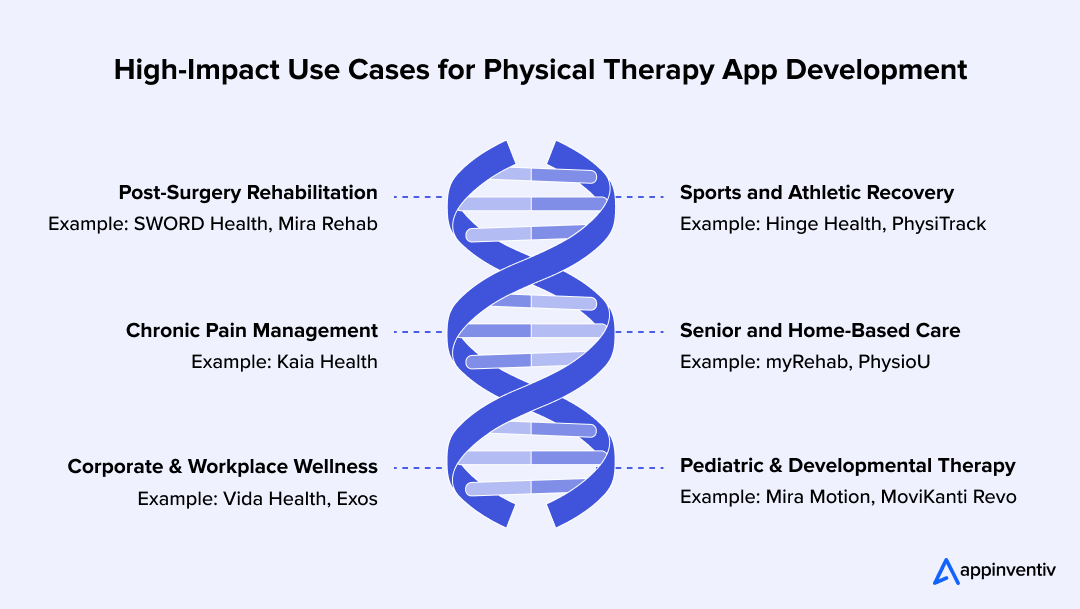
Post-Surgery Rehabilitation
Recovering patients need constant guidance, not constant travel. A custom physical therapy application gives them structured video routines, therapist feedback, and progress tracking that fits into daily life.
Example: SWORD Health and Mira Rehab use motion sensors and remote monitoring to help post-op patients regain mobility faster and avoid hospital readmissions.
Sports and Athletic Recovery
For athletes, recovery speed defines performance. AI-powered physiotherapy apps can analyze motion data and adapt exercises in real time, helping prevent re-injury and shorten downtime.
Example: Hinge Health and PhysiTrack are used by professional teams worldwide to track joint movement and optimize post-match recovery programs.
Chronic Pain Management
Chronic pain doesn’t always need clinic visits but needs consistency. Physical therapy mobile app development undertaken by businesses help their users follow daily exercise routines, monitor pain levels, and receive posture corrections directly on their phones.
Example: Kaia Health is known for using computer vision to guide people with back pain through proper movement, cutting reported pain levels significantly.
Senior and Home-Based Care
Elderly patients often miss therapy sessions due to mobility limits. Virtual physical therapy app development allows them to access tailored routines at home, with caregiver dashboards for monitoring progress safely.
Example: myRehab and PhysioU design programs that focus on flexibility and balance, helping older adults maintain independence longer.
Corporate and Workplace Wellness
Office jobs are fueling musculoskeletal issues like neck and back strain. Physical therapy practice management app development can help businesses provide preventive care and digital consultations to employees.
Example: Vida Health and Exos partner with global enterprises to reduce workplace injuries and improve long-term employee well-being.
Pediatric and Developmental Therapy
For children, therapy needs to feel like play. Physical therapy exercise application development that is backed by features like AR and gamification help improve motor skills while keeping kids engaged and excited.
Example: Mira Motion and MoviKanti Revo turn rehab into interactive games that build coordination through fun, trackable sessions.
Step-by-Step Process of Developing a HIPAA-Compliant Physical Therapy App
Let’s talk about how this really happens – not the perfect, corporate checklist kind of story, but the real-world version. Building a HIPAA-compliant physical therapy app isn’t just coding screens and adding encryption later. It’s about weaving privacy, usability, and healthcare logic together from day one. Here’s how teams that actually get it right go about it. Let’s look into the step-by-step process of developing an AI physiotherapy app:
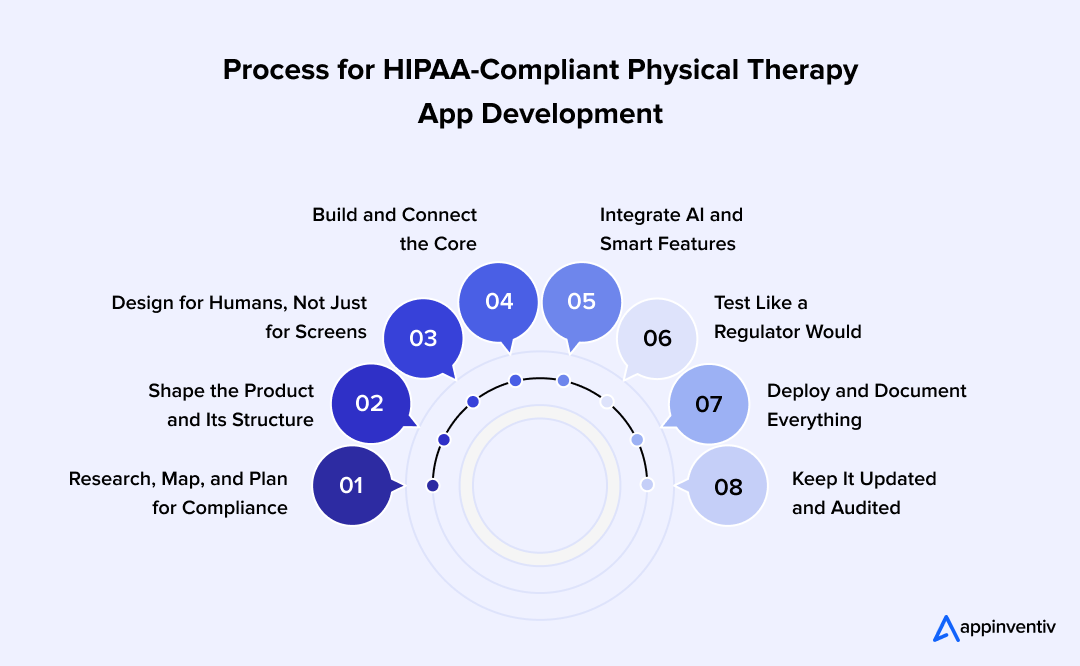
Step 1: Research, Map, and Plan for Compliance
Everything starts with groundwork. Before a single wireframe is drawn, the team sits down to understand two things – what patients and therapists actually need, and what the law says about handling their data. That’s where HIPAA comes in.
You figure out what kind of information your app will collect, how it moves through the system, and who touches it. Your team also decides early on where that data lives, how it’s protected, and what access rules apply. Most smart teams bring a compliance expert in right at this stage so that no one has to redo half the work later. It’s not exciting, but it’s what saves you from headaches down the line.
Step 2: Shape the Product and Its Structure
Once the healthcare compliance part is mapped, the real building starts. The discovery phase turns your idea into something tangible like sketches, flows, and system blueprints. This is where physical therapy app development starts taking form.
At this stage, teams also outline the tech stack for building a physical therapy application, choosing the right frameworks, databases, and cloud infrastructure that can support scalability, HIPAA compliance, and secure integrations. Architects design a setup that keeps sensitive data (PHI) separate from other app data. Everything that holds or moves medical info should use encrypted channels. If you’re hosting on the cloud, services like AWS or Azure or Google Cloud already offer HIPAA-ready configurations, but you still need to switch them on correctly.
Step 3: Design for Humans, Not Just for Screens
A good physical therapy mobile app should feel familiar even to someone who doesn’t use tech much. Think large buttons, clear exercise guides, and readable fonts. The same screen should work for a senior doing recovery stretches and for a therapist reviewing ten patients’ progress before lunch.
The UX part is where many apps go wrong due to over-design. The best ones stay simple, ask for consent upfront, and make every data access feel transparent. When users trust the app, engagement naturally follows.
Step 4: Build and Connect the Core
This is where development kicks in. Your physiotherapy app developers will begin with coding the backend, frontend, and all those little healthcare APIs that make things work together. But with healthcare apps, every connection matters. Video calls for virtual sessions need encryption. Wearable integrations must pass through secure APIs. Anything that touches medical records must go through proper authentication.
You’re basically building two apps in one – the user-facing product and a compliance layer that guards everything behind it. That’s what makes a HIPAA-compliant physical therapy app solid enough to scale later.
Step 5: Integrate AI and Smart Features
This is where intelligence gets added to the experience. AI integration turns a standard physiotherapy app into a real-time digital assistant for both therapists and patients. The development team connects motion tracking modules, predictive recovery models, and recommendation systems that personalize care based on user data.
It’s also the stage to train the algorithms responsibly, using anonymized datasets that comply with HIPAA and GDPR regulations. AI should never replace clinical judgment but should complement it by surfacing insights like progress trends, posture accuracy, or early signs of fatigue. For clinics, this translates into smarter decision-making and scalable, outcome-based care.
Step 6: Test Like a Regulator Would
HIPAA compliance testing here isn’t just about bugs. It’s about acting like a regulator with a checklist. QA teams run penetration tests, scan for vulnerabilities, and check encryption methods. Every single data flow, from sign-in to exercise upload, needs to be logged and traceable.
At this point, most teams bring in a third-party security audit. It’s a pain, yes, but it’s the only way to prove your app can actually protect what it promises to protect.
Step 7: Deploy and Document Everything
Once the app passes the tests, deployment happens on a HIPAA-compliant cloud setup. But the paperwork is as important as the tech. Privacy policies, Business Associate Agreements (BAAs), and consent management notes all need to be ready. Without them, you’re not legally covered, even if your code is flawless.
The goal here is transparency and showing exactly how user data moves and who’s responsible for each part of it.
Step 8: Keep It Updated and Audited
Compliance isn’t a one-time event. Laws change, security standards evolve, and apps age fast. The best teams set up ongoing checks, automatic updates, and yearly HIPAA audits. It keeps the app safe and patients confident.
Appinventiv’s Insight
At Appinventiv, we’ve learned that compliance isn’t just a legal checklist but is the foundation of user trust. Every healthcare product we’ve built, from digital rehab tools to full-scale hospital platforms, has shown the same pattern: when you design HIPAA protocols early and make them visible to end users, engagement rates rise. Patients don’t just use the app- they believe in it.
How Much Does It Cost to Build a HIPAA-Compliant Physical Therapy App
There’s no single price tag for physical therapy app development. The cost depends on how deep you want to go – whether you’re aiming for a quick proof-of-concept or a full-scale, compliant healthcare platform. You’re paying for far more than lines of code. Design, security, integrations, and HIPAA documentation all add weight to the budget. Cut corners here, and you’ll end up spending more later fixing compliance gaps or performance issues.
On average, the custom physical therapy application development cost starts around $50,000 for a basic MVP with essential modules like patient login, exercise tracking, and therapist dashboards. If you plan a full-featured system with AI-powered monitoring, secure tele-sessions, cloud hosting, and compliance automation, the bill can stretch to $300,000–$350,000+. That’s the reality of regulated healthcare tech, every layer of security and auditability adds time and cost, but it also builds long-term trust.
Here’s how a typical cost breakdown looks when developing a HIPAA-compliant physical therapy app:
| Phase | Timeline | Estimated Cost (USD) |
|---|---|---|
| Market Research & Planning | 3–4 weeks | $5,000 – $12,000 |
| UX/UI Design | 4–6 weeks | $8,000 – $25,000 |
| Core Development | 4–8 months | $40,000 – $120,000 |
| HIPAA Compliance & Security Setup | Parallel / ongoing | $15,000 – $40,000 |
| Testing & Quality Assurance | 1–2 months | $10,000 – $25,000 |
| Deployment & Documentation | 2–4 weeks | $3,000 – $10,000 |
| Maintenance & Support | Continuous | $2,000 – $12,000 per month |
The wide range of costs for physical therapy practice management app development reflects different goals. A clinic might only need a simple physical therapy exercise application, while a med-tech startup could invest in virtual physical therapy apps with wearable integration, data analytics, and AI-based posture tracking.
What really shifts the physical therapist mobile application development cost are five things:
- Feature complexity – More modules mean more engineering time.
- Level of HIPAA compliance – Encryption, BAAs, and access controls add overhead but are non-negotiable.
- Third-party integrations – EMR, telehealth, or wearable device APIs increase cost and testing time.
- Scalability goals – Apps built for one clinic cost far less than those meant for thousands of users.
- Developer expertise – Hourly rates differ widely across teams that have prior expertise in the same field.
Core Features of a Physical Therapy App
When it comes to digital healthcare, the basics still matter most. Even the smartest tools fail if patients find them hard to use or if therapists can’t access the right data at the right time. The following are the core features that make a physical therapy app work in real-world settings.
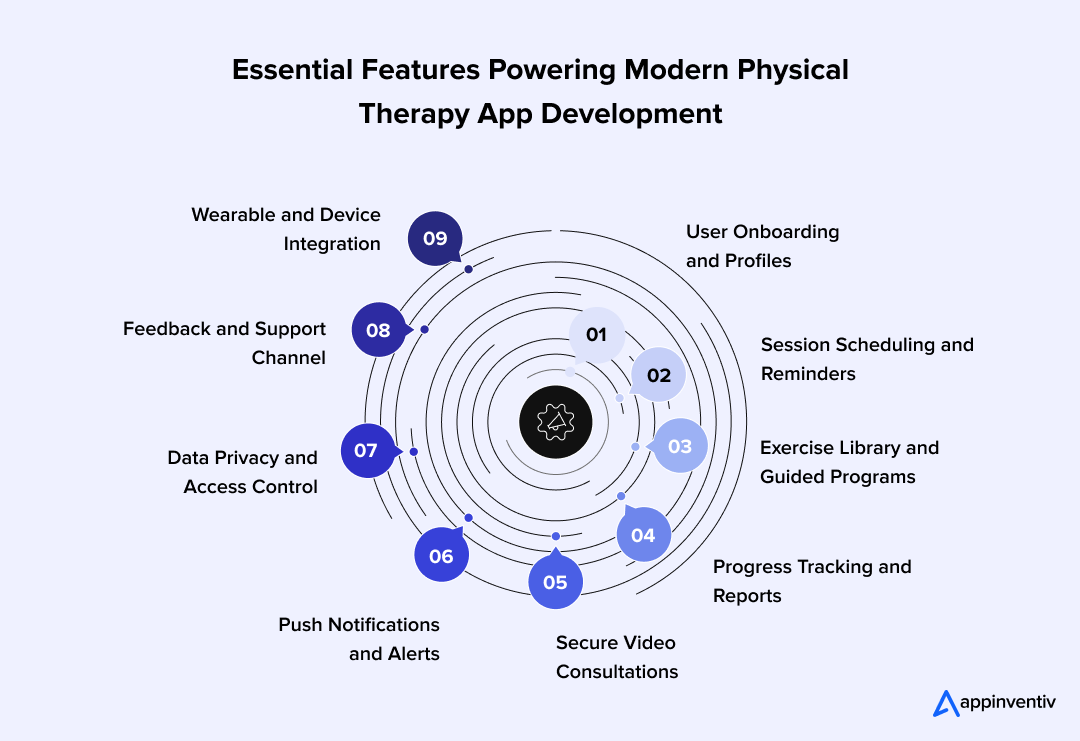
User Onboarding and Profiles
The sign-up flow should be fast and frictionless. Patients can create profiles with their medical history, therapy goals, and progress data. For therapists, profiles may include certifications and specialties to make assignments easier.
Session Scheduling and Reminders
Scheduling should feel natural – patients can book sessions, join virtual appointments, or reschedule without multiple calls. Automated reminders cut down on missed sessions and improve retention.
Exercise Library and Guided Programs
An interactive catalog of exercises with photos, short clips, or AR-based instructions helps patients follow routines correctly at home. Each plan can be tailored by the therapist to suit specific recovery stages.
Progress Tracking and Reports
Patients see how far they’ve come through visual trackers and performance graphs. Therapists can review compliance rates, adjust plans, and share updates directly from the dashboard.
Secure Video Consultations
Built-in video sessions make remote therapy simple. Therapists can observe patient posture, offer corrections, and document the session securely, all within the app.
Push Notifications and Alerts
Timely alerts for upcoming sessions, new plans, or reminders help patients stay consistent. The key is to keep notifications meaningful, not intrusive.
Data Privacy and Access Control
Since the app handles sensitive medical information, privacy settings must be easy to understand. Users should control who sees what, while the backend quietly manages encryption and compliance.
Feedback and Support Channel
A direct in-app feedback or chat feature helps users report issues, request clarifications, or rate their sessions. This closes the loop between the patient and provider.
Wearable and Device Integration
Smartwatch or motion sensor support lets therapists analyze movement data automatically, turning every session into measurable progress.
Advanced Features for an AI-Powered Physiotherapy App
The foundation gets the app running but it’s the extras that make it stand out. These features add intelligence, personalization, and business value.
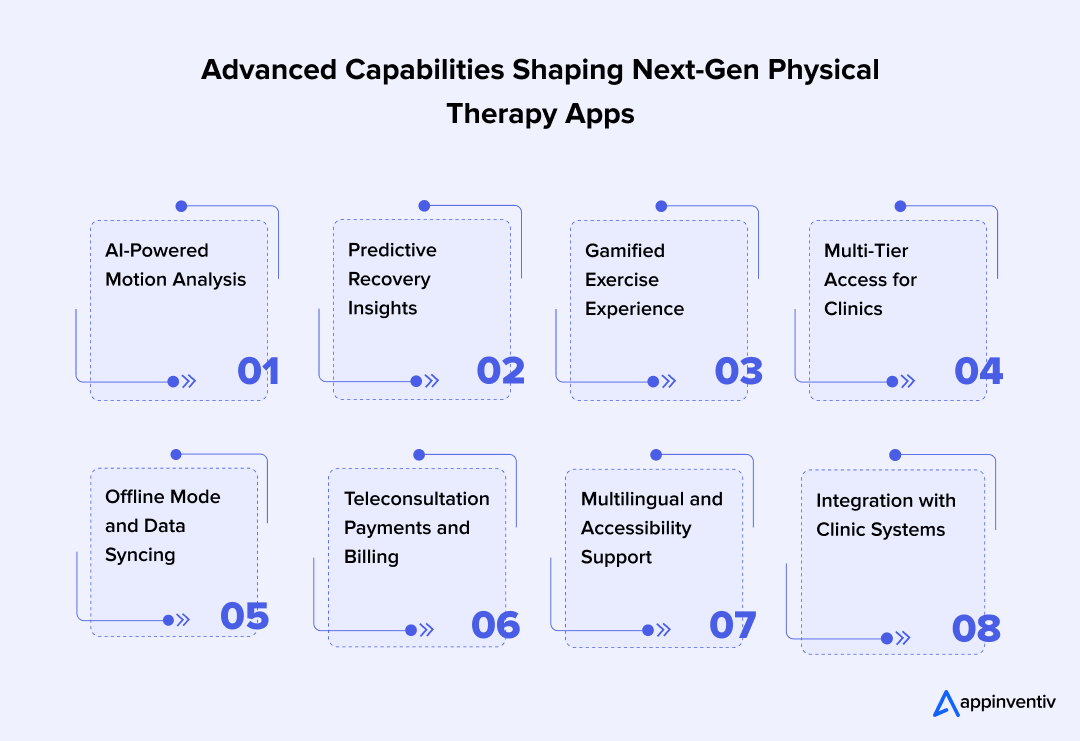
AI-Powered Motion Analysis
Machine learning can assess how accurately patients perform movements and suggest corrections. It’s like having a digital assistant that supports the therapist between visits.
Predictive Recovery Insights
Data from thousands of sessions helps forecast recovery time and flag risk of relapse. These insights allow therapists to adjust plans before problems appear.
Gamified Exercise Experience
Progress badges, streak counters, and achievement milestones make rehab feel rewarding. A little motivation keeps patients consistent and invested in their recovery.
Multi-Tier Access for Clinics
Larger setups can assign different roles like therapists, admins, and supervisors, each with their own permissions and analytics dashboard. It simplifies oversight while maintaining accountability.
Offline Mode and Data Syncing
In regions with unstable internet, the app can still work offline, saving exercise data and syncing automatically once a connection returns.
Teleconsultation Payments and Billing
Secure payment gateways let patients pay for sessions, subscriptions, or packages directly in-app, reducing administrative workload.
Multilingual and Accessibility Support
Simple language switches, subtitles, and audio guides help users of different ages and abilities navigate comfortably.
Integration with Clinic Systems
Connecting with EMR or EHR platforms creates one unified workflow, no double entry, no lost records.
Challenges of Physical Therapy App Development
Building a digital therapy platform isn’t as straightforward as most tech projects. Healthcare adds an extra layer of complexity revolving around regulations, privacy concerns, and real patient outcomes.
While physical therapy exercise application development opens big opportunities, it also brings practical challenges that can slow progress or inflate costs if not addressed early. The good news is that each challenge has a clear path to resolution when planned with the right mix of technology and compliance expertise.
| Challenge | How It Affects the Project | How to Resolve It |
|---|---|---|
| HIPAA Compliance and Data Security | Storing and transferring Protected Health Information (PHI) without proper encryption can lead to serious legal penalties and loss of trust. | Build on HIPAA-compliant cloud infrastructure, use encryption at rest and in transit, and maintain detailed audit logs. Regular healthcare data security audits and Business Associate Agreements (BAAs) are non-negotiable. |
| Complex Integrations with EMR/EHR Systems | Linking with hospital or clinic systems often causes delays due to inconsistent data formats and security layers. | Use standardized FHIR or HL7 APIs, test data syncs in sandbox environments, and work with integration specialists who understand healthcare interoperability. |
| Maintaining User Engagement | Patients often lose motivation after a few sessions, reducing therapy success rates and app retention. | Add gamified exercises, progress trackers, and reminder notifications. AI-based personalization keeps users motivated through dynamic recovery plans. |
| Device Compatibility and Wearable Integration | Inconsistent data from different sensors or mobile devices can disrupt tracking accuracy. | Choose widely supported SDKs, create fallback modes for unsupported devices, and validate all data through calibration routines. |
| Balancing UX with Accessibility | Older adults or patients with limited digital literacy can find apps confusing or hard to navigate. | Use large fonts, clear icons, and simple workflows. Conduct usability tests with real patients to refine accessibility features. |
| Performance and Scalability | Slow load times or app crashes during peak hours damage credibility and user trust. | Adopt microservice architecture, cache frequently used data, and use cloud auto-scaling for consistent performance. |
| High Development and Maintenance Costs | Advanced AI features, security certifications, and long QA cycles can drive budgets higher than expected. | Start with a minimum viable product (MVP) and scale gradually. Outsource specialized tasks like compliance or AI modeling to reduce overhead. |
| Ensuring Clinical Accuracy | Incorrect or outdated exercise content can harm patients and create liability risks. | Partner with licensed physiotherapists, review exercise libraries regularly, and integrate expert validation workflows into content updates. |
Future Trends of Physical Therapy Apps: Redefining the
If you look at where healthcare tech is heading, physical therapy app development is right in the middle of it. The next few years aren’t just about digitizing therapy but are mostly about connecting people, data, and devices in ways that make recovery feel more personal and less clinical. The focus is shifting from “apps that instruct” to “apps that learn and adapt.” Here’s what’s starting to take shape.
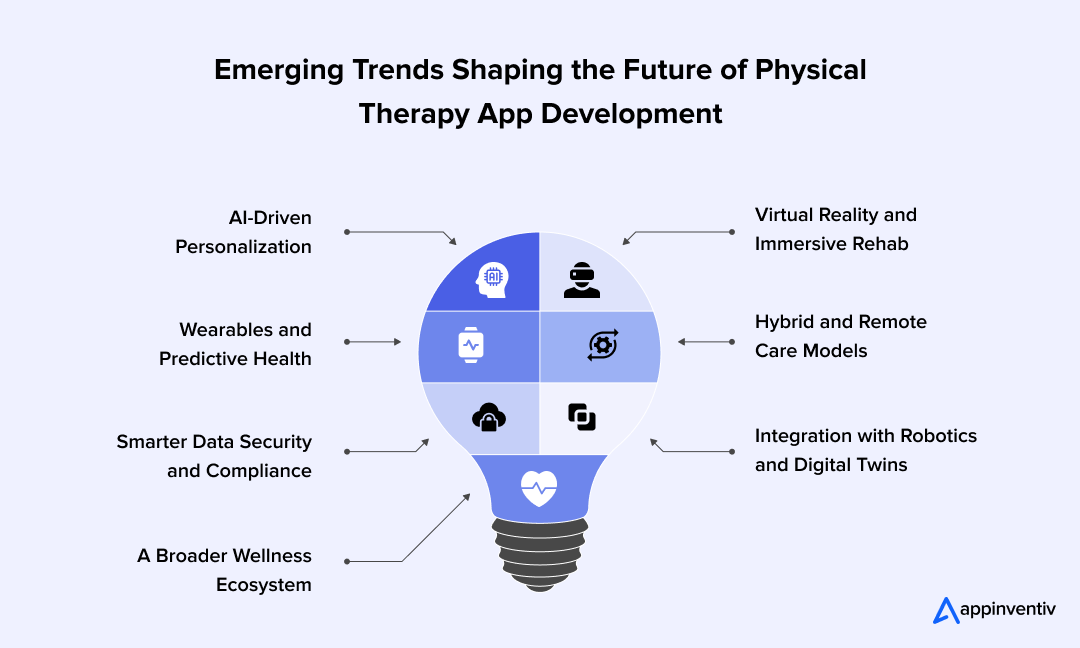
AI-Driven Personalization
We’re moving past fixed routines. The new AI-powered physiotherapy apps learn from how patients move – the speed, range, and frequency of each exercise. Over time, the app starts predicting what works best for a specific person and adjusts the plan automatically. It’s not about replacing therapists; it’s about giving them better insight into what’s happening between visits.
Here’s what you can expect:
| AI Capability | How It Transforms Physiotherapy Apps | Value for Healthcare Businesses |
|---|---|---|
| Motion Recognition Algorithms | Detects joint angles, movement precision, and posture deviations in real time. | Reduces manual supervision time and improves treatment accuracy. |
| Adaptive Exercise Recommendation Engine | Dynamically modifies exercise plans based on performance, pain feedback, and recovery pace. | Keeps patients engaged while personalizing care at scale. |
| Predictive Recovery Analytics | Analyzes large sets of anonymized session data to forecast recovery timelines. | Helps clinics plan resources efficiently and deliver measurable outcomes. |
| AI-Powered Progress Insights | Converts raw motion data into visual insights for both patients and therapists. | Improves transparency and builds long-term trust between users and providers. |
| Conversational AI for Therapy Guidance | Offers voice-assisted feedback and reminders during at-home sessions. | Enhances patient adherence, especially for elderly or remote users. |
| Computer Vision–Based Posture Correction | Uses smartphone cameras or connected wearables to identify incorrect movements instantly. | Minimizes risk of re-injury and supports continuous remote supervision. |
Virtual Reality and Immersive Rehab
Rehab can be boring, and most people lose interest fast. That’s why clinics are experimenting with VR-based therapy. Patients wear a headset, follow guided exercises in an interactive environment, and forget they’re doing medical work. As virtual physical therapy apps start including VR modules, recovery feels more like a game and less like a task.
Wearables and Predictive Health
Smartwatches and motion trackers are already helping therapists collect data beyond the clinic. The next step is connecting that data directly to physical therapy mobile apps so progress reports update automatically. If the system spots a movement pattern that could lead to strain or relapse, it flags it early. That kind of prediction saves both time and discomfort.
Hybrid and Remote Care
Therapy is becoming flexible. People may see their therapist in person once a week and use the app for the rest of their sessions. This hybrid model keeps treatment consistent while cutting travel time. Building physical therapy applications that can blend live and remote care smoothly will soon be the new norm for clinics.
Smarter Data Security and Compliance
More data means more risk, which is why future HIPAA-compliant physical therapy apps are putting privacy at the center. Instead of reacting to breaches, they’re built to predict and block them. Real-time threat monitoring, encrypted video calls, and automatic compliance audits are slowly becoming part of the design, not an afterthought.
Integration with Robotics and Digital Twins
One major leap ahead will be the use of robotic assistance and digital twins in therapy. Imagine an app that builds a 3D model of a patient’s musculoskeletal system and tests recovery scenarios virtually before suggesting an exercise routine. Pair that with robotic braces or exoskeleton feedback, and therapy becomes both precise and measurable.
A Broader Wellness Ecosystem
The line between therapy and wellness is fading. The same app that tracks your rehab might soon track your sleep, nutrition, and stress levels too. By pulling all that together, the app helps people stay healthy long after formal therapy ends. It’s a shift from short-term recovery to lifelong mobility and balance.
Appinventiv’s Insight
In our healthcare collaborations, we’ve seen how AI in physical therapy is moving from passive tracking to active care support. When motion analysis tools are combined with therapist input, recovery programs become more adaptive and patient-specific. What used to be a data stream now functions as a live feedback system – one that helps clinicians make faster, evidence-based adjustments.
Why Partner with Appinventiv for Your Physical Therapy App Development
Knowing how much physical therapy app development costs is only one side of the story. The real challenge is turning that budget into a product that patients trust and therapists actually enjoy using. That’s where Appinventiv comes in – a partner that understands HIPAA healthcare, compliance, and technology down to the smallest detail.
Experience That Builds Confidence
We’ve spent years helping healthcare organizations and startups turn complex ideas into simple, secure, and scalable products. As a healthcare app development company, our experience covers everything from HIPAA-compliant physical therapy apps to enterprise-grade hospital systems. That background means we know how to balance usability with regulation, so your app works smoothly for patients, therapists, and administrators alike.
For instance, we recently developed DiabeticU, a HIPAA-compliant healthcare app that helps patients manage chronic conditions more effectively. Beyond prescription tracking and remote consultations, the platform also allows users to monitor their daily physical activity and wellness progress through connected devices and AI-driven insights.
Security from the Ground Up
Healthcare apps deal with highly sensitive information. One breach can erase years of trust. At Appinventiv, security isn’t an afterthought but a part of the foundation. Every physical therapy mobile app development project we undertake follows strict encryption standards, secure logins, and ongoing compliance audits to keep patient data safe.
Custom-Built, Never Cookie-Cutter
No two clinics or startups have the same goals. Some want a quick launch to test adoption, while others need a fully customized virtual physical therapy app with AI tracking and global reach. We don’t force templates but build around your needs, your workflow, and your growth plans.
Designed for Scale and Stability
Launching is easy; scaling is where most apps fail. Our architecture is built to handle growth without performance drops. Whether your app runs on iOS, Android, or both, it’s designed to grow with your business.
Long-Term Partnership and Support
We don’t disappear after deployment. The healthcare space evolves quickly, and staying compliant means keeping up with new rules and technologies. Our post-launch support covers everything from new feature releases to continuous security updates and maintenance.
If you’re ready for building a physical therapy application that goes beyond the basics, Appinventiv will be right beside you, shaping every step from strategy to scale. Get in touch with our experts now!
FAQs
Q. How do physiotherapy apps work?
A. They work a lot like a remote assistant for both sides. A patient signs in, picks up their plan, and follows exercises with short clips or guided timers. The app records how often they practice and how well they move. On the other side, the therapist can peek at the numbers, check progress, and change routines without waiting for the next visit. It’s basically turning therapy into something that fits daily life instead of breaking it up into weekly appointments.
Q. How is AI changing physiotherapy treatment in 2025?
A. The change is already happening. New AI-powered physiotherapy apps can read posture from a phone camera, spot wrong angles, and correct them on the spot. Over time, the system starts seeing patterns – where a patient slows down, when fatigue hits, when recovery plateaus. It’s not magic, just data used right. Therapists get more insight; patients get faster results.
Q. How much does physical therapy app maintenance cost?
A. It’s an ongoing cost, not a one-off. Most HIPAA-compliant physical therapy app development costs somewhere between $2,000 to $12,000 a month to maintain. That covers updates, bug fixes, privacy checks, and feature tweaks. In healthcare, skipping maintenance usually costs more later as compliance rules shift, and software ages fast.
Q. How long does it take to build a physical therapy app?
A. Timelines stretch depending on what you’re building. A simple pilot might be ready in about three months. A full virtual physical therapy app with wearables, AI tracking, and secure video can take eight months or more. The longest part isn’t the coding but is the testing and the paperwork that keeps it compliant.
Q. What kind of ROI do CEOs actually see from HIPAA-compliant physical therapy app development?
A. The return isn’t a single number. It shows up as lower admin time, steadier patient retention, and fewer no-shows. Once an app runs smoothly, clinics handle more patients without expanding headcount. The data from those sessions can also be reused and helps shape new programs, better pricing, smarter marketing. That’s long-term ROI, not short-term hype.
Q. What are the common mistakes companies make when building a HIPAA-compliant physical therapy app?
A. The first is jumping straight into design before touching compliance. Teams build the pretty stuff, then realize later that their database isn’t set up for HIPAA-compliance. Now, fixing that after launch burns time and money. The second mistake: treating updates like optional. Regulations keep moving. If you’re not checking security and access logs every few months, you’re already behind.


- In just 2 mins you will get a response
- Your idea is 100% protected by our Non Disclosure Agreement.

How Much Does It Cost to Build a Healthcare App in Saudi Arabia? All You Need to Know
Key takeaways: Healthcare app costs in Saudi Arabia range from 112,500 SAR to 2,250,000+ SAR based on size and complexity. The type of app you build matters more to cost than anything else. Compliance, security, and scalability are built into the cost, not add-ons. Development and testing consume the largest share of the budget. Hidden…
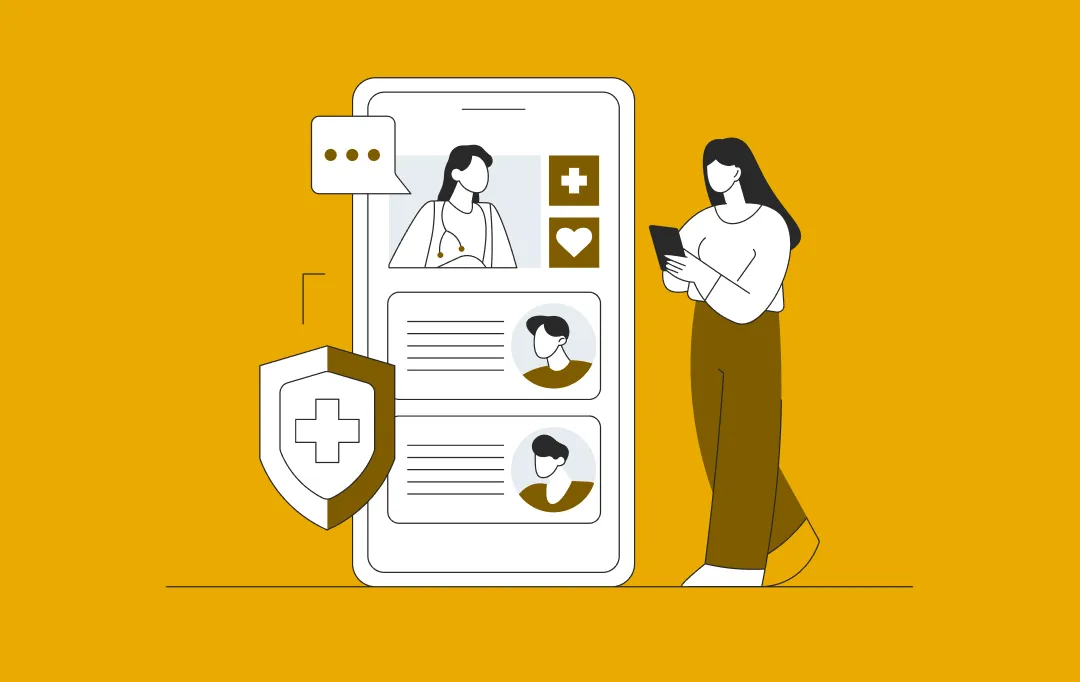
How Prescriptive Analytics Is Shaping the Future of Healthcare Management
A healthcare business doesn’t fall behind because its teams lack skill. It falls behind when decisions take too long. Bed allocation runs on yesterday’s data. Procurement reacts only when shortages hit. Care managers step in after a patient is already at risk. And leadership gets a picture of what’s happening only after the quarter closes,…
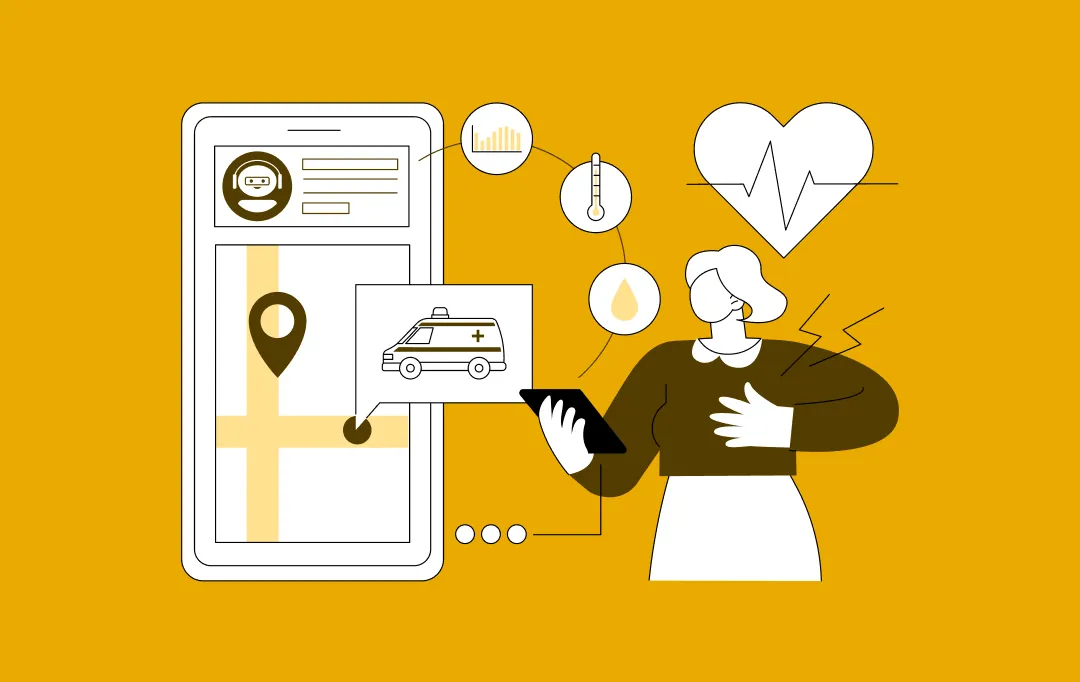
How to Build an Urgent Care App? A Step-by-Step Process, Features and Costs
Key takeaways: With more people turning to digital healthcare, the urgent care app market is expected to touch $3.1 billion by 2024 and continue growing fast through 2030. Apps that offer easy scheduling, video consultations, EHR access, and quick insurance handling tend to attract more users and keep them coming back. Developing an urgent care…












